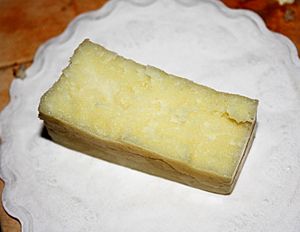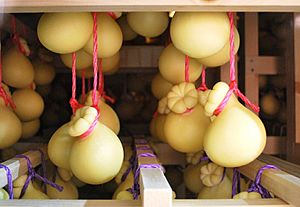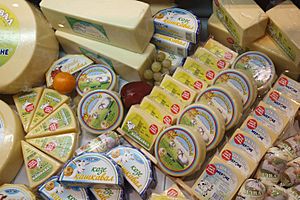Kashkaval facts for kids
Quick facts for kids Kashkaval |
|
|---|---|
 |
|
| Country of origin | Lua error in Module:Wikidata at line 70: attempt to index field 'wikibase' (a nil value). |
| Source of milk | Cow, sheep, buffalo, goat |
| Pasteurised | Traditionally, no |
| Texture | Semi-hard |
| Named after | Lua error in Module:Wikidata at line 70: attempt to index field 'wikibase' (a nil value). |
Kashkaval is a tasty type of cheese. It is usually made from cow's milk, sheep's milk, or a mix of both. In many countries like Albania, Bulgaria, North Macedonia, Serbia, and Romania, the word "kashkaval" often means any kind of yellow cheese. It's a very popular food in these regions!
Contents
What's in a Name?
The name kashkaval might come from Latin words meaning 'cheese' and 'horse'. This idea comes from an Italian cheese called caciocavallo. This cheese was traditionally dried by hanging two round pieces over a wooden pole. It looked a bit like saddlebags hanging on a horse's back!
There's another idea about where the name came from. Some experts think it was created by the Aromanians, who live in the Balkans. In their language, the word caș means 'cheese'. This theory connects the name to the way these people moved their animals between summer and winter pastures.
Where is Kashkaval Popular?
Albania
In Albania, kaçkavall is one of the most popular cheeses. It's a traditional Albanian food. Many restaurants will even bring you plates of raw or fried kaçkavall for free! Most dairy companies in Albania make kaçkavall using milk from cows or sheep.
Bulgaria
In Bulgaria, kashkaval made from cow's milk is called kashkaval vitosha. If it's made from sheep's milk, it's known as kashkaval balkan. There's also kashkaval preslav, which is made from a mix of both milks.
Kashkaval is often used in breakfast pastries. A common dish is kashkavalka, which is a small pastry with kashkaval inside and on top. Another popular snack is princesa, a grilled slice of bread topped with kashkaval. It's also a favorite for pizzas!
Israel
Kashkaval is very popular in Israel. Many people there have family roots in Eastern and Southeastern Europe, where this cheese is common.
Romania and Moldova
In Romania and Moldova, cașcaval is a general name for many yellow, medium-hard cheeses. These cheeses are made from sheep's or cow's milk. Some well-known types include dobrogea (sheep's milk) and rucăr (cow's milk).
People in Romania often use "cașcaval" to describe any semi-hard yellow cheese. This includes cheeses like Swiss Emmental or Dutch Gouda. Many Romanian dishes use cașcaval, such as cașcaval pane (fried cheese) or mămăligă (a type of polenta).
North Macedonia
Kashkaval cheese is also very popular in North Macedonia. It's mostly made from cow's milk. However, you can also find versions made from sheep's milk or a mix of both. In North Macedonia, "kashkaval" is often used as a general word for any yellow cheese. If you just say "cheese," people usually think of white cheese like feta.
Russia
Kashkaval cheese is also popular in Russia. Besides the cheeses from the Balkans and Italy, Russia has its own version of kashkaval.
Serbia
In Serbia, kačkavalj is traditionally a hard cheese made from sheep's milk. The city of Pirot has a special protected brand of this cheese. Other cheeses made from mixed milk might be called kačkavalj, but they are not the famous pirotski (from Pirot) kind.
Kačkavalj is one of Serbia's six traditional cheeses. It's believed that cheesemakers from Dalmatia or Italy brought the cheese-making process to Pirot in the 1810s.
Levant
In the Levant region (which includes Syria, Jordan, Palestinian territories, Israel, and Lebanon), qashqawān is often used as a melting cheese. It's especially popular in pastries. The type of kashkaval found here is often similar to the Hungarian style.
See also
 In Spanish: Kashkaval para niños
In Spanish: Kashkaval para niños




